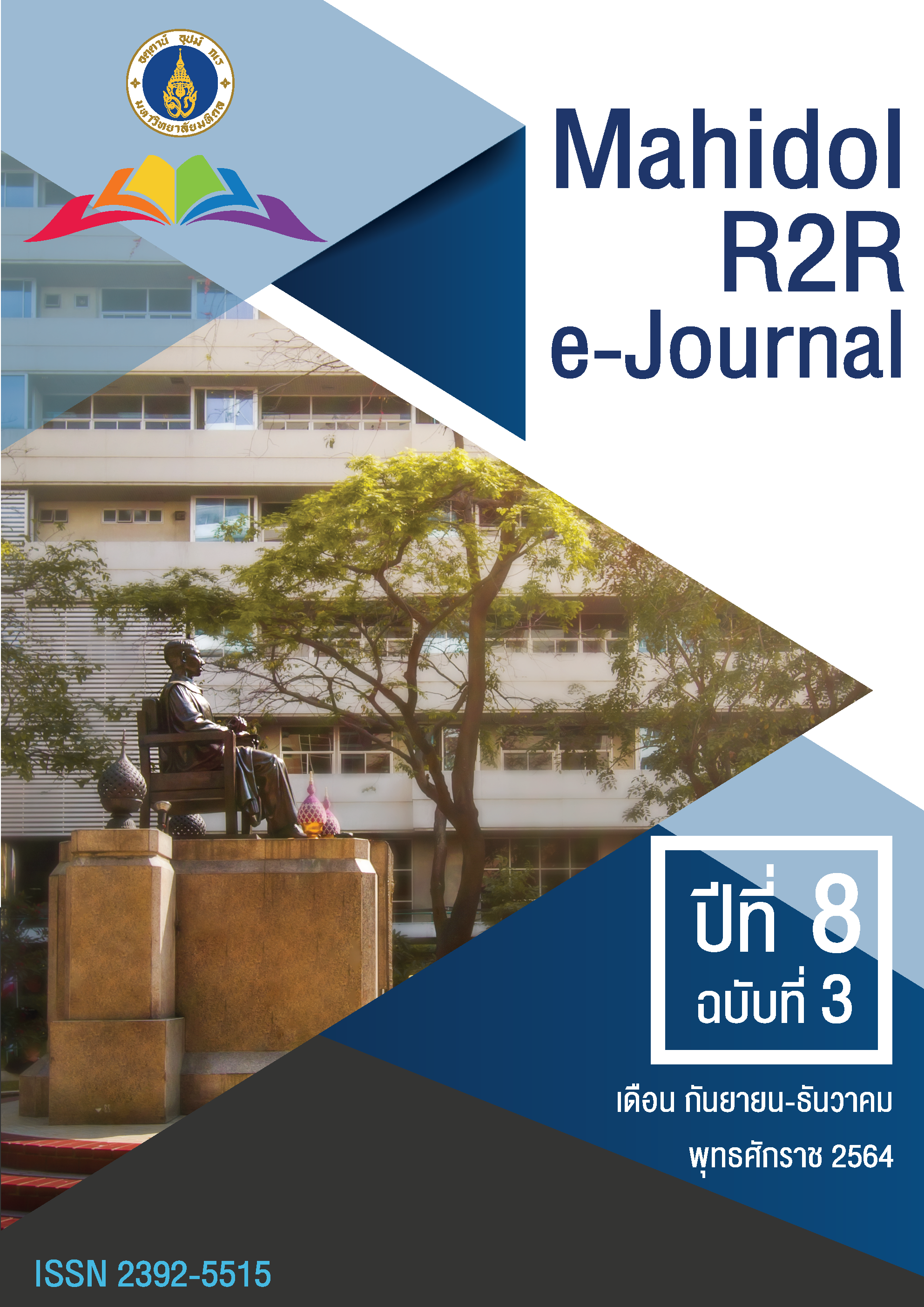แนวทางการจัดการกระบวนการผลิตตำราสายสังคมศาสตร์เพื่อการพัฒนาเชิงสร้างสรรค์
DOI:
https://doi.org/10.14456/jmu.2021.34คำสำคัญ:
การจัดการกระบวนการผลิตตำราสายสังคมศาสตร์, การพัฒนาเชิงสร้างสรรค์บทคัดย่อ
บทความนี้วัตถุประสงค์เพื่อศึกษาแนวทางการจัดการกระบวนการผลิตตำราเพื่อการพัฒนาเชิงสร้างสรรค์ ของอาจารย์สายสังคมศาสตร์ เป็นการศึกษาเชิงคุณภาพที่ยึดถือกระบวนทัศน์การตีความ ตามทฤษฎีเชิงระบบ IPO Model ของ Ludwig ,Von Bertalanffy (1968) กลุ่มเป้าหมายเป็นอาจารย์ในระดับบัณฑิตศึกษา ของเครือข่ายบัณฑิตศึกษา มหาวิทยาลัยราชภัฏภาคเหนือ จำนวน 40 คน โดยเน้นการสัมภาษณ์เชิงลึก
ผลการศึกษาพบว่า 1) ต้นทางหรือ วัตถุดิบ (Material) ที่ใส่เข้าไปในระบบ เช่น การเป็นคนเรียนรู้รอบด้านและเชื่อมโยงความรู้ในทุกอย่าง (being a person learning all around and linking knowledge in everything ) มีใจรักและศรัทธาในเป้าหมายของงานที่ทำอย่างเต็มหัวใจ มีความชัดเจนในหลักการของคำว่าตำรา การเขียนตำราจากงานวิจัย มีกัลยาณมิตรในการช่วยเหลือ เช่นครูพี่เลี้ยง หรือแม้แต่ลดงานด้วยเทคโนโลยี (even reduced work with technology) และการเป็นบุคคลแห่งความสงบสุข 2) ในด้านกระบวนการ (Process) เริ่มตั้งแต่การเขียนความนำ (Introduction) การเขียนเนื้อหา การเขียนสรุป กระบวนการเหล่านี้ จะต้องแตกต่าง จากตำราเดิม ๆ คือมีความลุ่มลึกในศาสตร์ที่ทำผนวกกับการเป็นนักคิดนักพัฒนาเชิงสร้างสรรค์ จนการสร้างความรู้เชิงบูรณาการผนวกทุกศาสตร์ให้เป็นหนึ่งเดียว (Integration Instruction) พร้อมนำไปทดลองสอน นำเสนอให้กัลยาณมิตร ครูพี่เลี้ยง หรือผู้ทรงคุณวุฒิช่วยตรวจสอบ แล้วนำมาปรับปรุงแก้ไข และ 3) ปลายทาง (Downstream) หรือปลายน้ำ คือการเผยแพร่ตำราตามเกณฑ์มาตรฐานสากล ซึ่งกระบวนการทั้งหมดสัมพันธ์และสอดคล้องกัน และมีคุณค่าในแต่ละห่วงโซ่
เอกสารอ้างอิง
Bodhisita, C.(2007).Science and art of qualitative research. 3rd edition, Bangkok: Amarin Printing. [in Thai]
Center for Integrating Research and Academic Service for Social Service Research and Development Institute Uttaradit Rajabhat University (2015). System and mechanism for integratingthe mission of Uttaradit Rajabhat University with society. Academic Documents Center for Integrated Research and Academic Affairs To serve societyNo.003/2015, Uttaradit Rajabhat University. [in Thai]
Charoenwongsak, K .(2013). Creative thinking. 6th Edition.Bangkok: Success Media Co., Ltd. [in Thai]
Mumford, D. Michael. (2012). Hanbook of Organizational Creativity. United States of America: Elsevier.
Suwansawat,S.(2018).Council of University Presidents of Thailand Through the University Expo, selected activities and exhibitions Inspire. Answers Thailand 4.0. Retrieved August 10,2018 ,from http://unixpo.cupt.net/wpcontent/uploads/2018/02. [in Thai]
Suranaree University of Technology .(2016).The roles of University in Entrepreneurship Ecosystem By Ministry of Science And Technology National Science Technology and Innovation Policy Office. Retrieved August 10, 2016, from http://www.sut.ac.th/2012/news/detail/4/news20160825. [in Thai]
Siriwong ,P.and Sengdaeng,P. (2011). The Traveling of Physically Disabled in Thailand. Veridian E Journal,Silpakorn University (Humanities,Social Sciences and arts). Vol. 4 No. 2: September-December 2011:221-228.
Von Bertalanffy, L. (1968). General System Theory: Foundations, Development, Applications. New York: George Braziller.
Wongyai, W.and Patpol,M.(2020). Creative Learning. Bangkok: Charansanitwong Printing Co., Ltd.
ดาวน์โหลด
เผยแพร่แล้ว
ฉบับ
ประเภทบทความ
สัญญาอนุญาต




